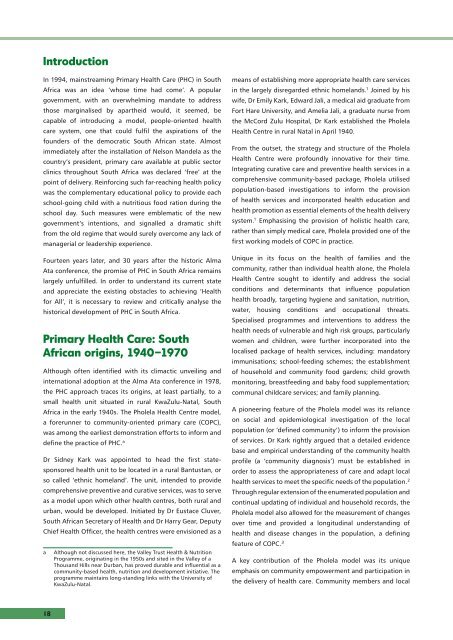South African Health Review 2008 - Health Systems Trust
South African Health Review 2008 - Health Systems Trust
South African Health Review 2008 - Health Systems Trust
You also want an ePaper? Increase the reach of your titles
YUMPU automatically turns print PDFs into web optimized ePapers that Google loves.
Introduction<br />
In 1994, mainstreaming Primary <strong>Health</strong> Care (PHC) in <strong>South</strong><br />
Africa was an idea ‘whose time had come’. A popular<br />
government, with an overwhelming mandate to address<br />
those marginalised by apartheid would, it seemed, be<br />
capable of introducing a model, people-oriented health<br />
care system, one that could fulfil the aspirations of the<br />
founders of the democratic <strong>South</strong> <strong>African</strong> state. Almost<br />
immediately after the installation of Nelson Mandela as the<br />
country’s president, primary care available at public sector<br />
clinics throughout <strong>South</strong> Africa was declared ‘free’ at the<br />
point of delivery. Reinforcing such far-reaching health policy<br />
was the complementary educational policy to provide each<br />
school-going child with a nutritious food ration during the<br />
school day. Such measures were emblematic of the new<br />
government’s intentions, and signalled a dramatic shift<br />
from the old regime that would surely overcome any lack of<br />
managerial or leadership experience.<br />
Fourteen years later, and 30 years after the historic Alma<br />
Ata conference, the promise of PHC in <strong>South</strong> Africa remains<br />
largely unfulfilled. In order to understand its current state<br />
and appreciate the existing obstacles to achieving ‘<strong>Health</strong><br />
for All’, it is necessary to review and critically analyse the<br />
historical development of PHC in <strong>South</strong> Africa.<br />
Primary <strong>Health</strong> Care: <strong>South</strong><br />
<strong>African</strong> origins, 1940–1970<br />
Although often identified with its climactic unveiling and<br />
international adoption at the Alma Ata conference in 1978,<br />
the PHC approach traces its origins, at least partially, to a<br />
small health unit situated in rural KwaZulu-Natal, <strong>South</strong><br />
Africa in the early 1940s. The Pholela <strong>Health</strong> Centre model,<br />
a forerunner to community-oriented primary care (COPC),<br />
was among the earliest demonstration efforts to inform and<br />
define the practice of PHC. <br />
Dr Sidney Kark was appointed to head the first statesponsored<br />
health unit to be located in a rural Bantustan, or<br />
so called ‘ethnic homeland’. The unit, intended to provide<br />
comprehensive preventive and curative services, was to serve<br />
as a model upon which other health centres, both rural and<br />
urban, would be developed. Initiated by Dr Eustace Cluver,<br />
<strong>South</strong> <strong>African</strong> Secretary of <strong>Health</strong> and Dr Harry Gear, Deputy<br />
Chief <strong>Health</strong> Officer, the health centres were envisioned as a<br />
<br />
Although not discussed here, the Valley <strong>Trust</strong> <strong>Health</strong> & Nutrition<br />
Programme, originating in the 1950s and sited in the Valley of a<br />
Thousand Hills near Durban, has proved durable and influential as a<br />
community-based health, nutrition and development initiative. The<br />
programme maintains long-standing links with the University of<br />
KwaZulu-Natal.<br />
means of establishing more appropriate health care services<br />
in the largely disregarded ethnic homelands. 1 Joined by his<br />
wife, Dr Emily Kark, Edward Jali, a medical aid graduate from<br />
Fort Hare University, and Amelia Jali, a graduate nurse from<br />
the McCord Zulu Hospital, Dr Kark established the Pholela<br />
<strong>Health</strong> Centre in rural Natal in April 1940.<br />
From the outset, the strategy and structure of the Pholela<br />
<strong>Health</strong> Centre were profoundly innovative for their time.<br />
Integrating curative care and preventive health services in a<br />
comprehensive community-based package, Pholela utilised<br />
population-based investigations to inform the provision<br />
of health services and incorporated health education and<br />
health promotion as essential elements of the health delivery<br />
system. 1 Emphasising the provision of holistic health care,<br />
rather than simply medical care, Pholela provided one of the<br />
first working models of COPC in practice.<br />
Unique in its focus on the health of families and the<br />
community, rather than individual health alone, the Pholela<br />
<strong>Health</strong> Centre sought to identify and address the social<br />
conditions and determinants that influence population<br />
health broadly, targeting hygiene and sanitation, nutrition,<br />
water, housing conditions and occupational threats.<br />
Specialised programmes and interventions to address the<br />
health needs of vulnerable and high risk groups, particularly<br />
women and children, were further incorporated into the<br />
localised package of health services, including: mandatory<br />
immunisations; school-feeding schemes; the establishment<br />
of household and community food gardens; child growth<br />
monitoring, breastfeeding and baby food supplementation;<br />
communal childcare services; and family planning.<br />
A pioneering feature of the Pholela model was its reliance<br />
on social and epidemiological investigation of the local<br />
population (or ‘defined community’) to inform the provision<br />
of services. Dr Kark rightly argued that a detailed evidence<br />
base and empirical understanding of the community health<br />
profile (a ‘community diagnosis’) must be established in<br />
order to assess the appropriateness of care and adapt local<br />
health services to meet the specific needs of the population. 2<br />
Through regular extension of the enumerated population and<br />
continual updating of individual and household records, the<br />
Pholela model also allowed for the measurement of changes<br />
over time and provided a longitudinal understanding of<br />
health and disease changes in the population, a defining<br />
feature of COPC. 3<br />
A key contribution of the Pholela model was its unique<br />
emphasis on community empowerment and participation in<br />
the delivery of health care. Community members and local<br />
18
















